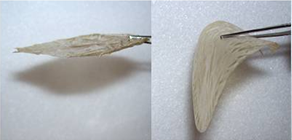| Search for content and authors |
Crystallization in Chitosan Membrane due to Lithium – A Potential Topic in Solid State Polymer Electrolytes for Batteries |
| Suraiya Begum , Saravanan Annamalai , Radha Perumal Ramasamy |
|
Anna University, Department of Applied Science and Technology, ACT campus (ACT), Chennai 600 025, India |
| Abstract |
| Solid state polymer electrolytes for Lithium ion batteries using biodegradable polymers are gaining scientific attention recently. Chitosan is a biodegradable polymer which shows partly amorphous and partly crystalline nature. The most popularly used solvent for chitosan dissolution is acetic acid solution, which acts as a cross linker for the formation of membranes. Studies relating to the interactions between Lithium and Chitosan membrane are important for using chitosan as a membrane in batteries. In this work, we study the influence of lithium ions on the crystallinity of chitosan membrane. The polymer membranes containing chitosan, acetic acid and lithium ions were prepared using solution casting method. In our experiment to the chitosan solution (10g/L) acetic acid was added to have a final concentration of 0.25 M/L. The solution was stirred while heating at 60°C for 30 min. To this LiClO4 was added to have a final concentration of 5g/L. The solution was mixed for 30 min and then casted as films using glass Petri dish. It was observed that the films made using LiClO4 was more flexible than those made without it (Fig. 1). XRD pattern for chitosan - acetic acid films (Fig. 2) shows peak with 2θ angle at 11.5° and broad peak at 18.2°, 30° and 42°. Previously it has been shown that chitosan films made with 0.5M/L of acetic acid and 10g/L of chitosan has two unit cells. The unit cell of crystals (1) is larger than that of crystal (2), also the intensities of 2θ angle at 18.2° was nearly the same as that of 11.5° [1]. For our samples the concentration of acetic acid is 0.25M/L and 10g/L of chitosan. The intensity for 2θ angle at 11.5° was found to be less than that of 2θ angle at 18.5°. Thus, the reduction in the intensity of peak with 2θ angle at 11.5° (crystal (1)) to the lesser acetic acid contribution (0.25m/L) as against 0.5M/L acetic acid used in Samuels et al [2]. Chitosan solution with 50%LiClO4 did not show any peak at 11.5° or 18.2°. But it shows broad peaks with 2θ angles at 20°, 30° and 41°. The absence of peaks with 2θ angles at 11.5° and 18.2° indicate that the formation of crystals due to acetic acid has been suppressed due to incorporation of lithium, thereby reducing the interaction of acetic acid with chitosan. The suppression of interaction between acetic acid and chitosan by lithium should be the reason for the membranes containing lithium to be more flexible than those of without lithium. Also this could happen because of formation of complexes involving lithium and acetic acid (lithium acetate). AFM could not image the chitosan- lithium ion membrane as it was very smooth and soft and could not be scanned. Raman spectra showed that the films are amorphous. Light scattering showed that complexes were formed when LiClO4 was incorporated. The sizes of the complexes are ~ 100 nm. Room temperature measurement of the conductivity of the films showed that the films containing Lithium had 2000 times the conductivity of chitosan films without LiClO4. The mechanical properties and the electrical characteristics of the films will also be discussed.  A B A BFigure 1: Optical images of (A) Chitosan (B) Chitosan with 50% LiClO4
Figure 2: XRD pattern for the Chitosan films and powder. References 1.C.G.A. Lima, DC conductivity and dielectric permittivity of collagen–chitosan films, Materials Chemistry and Physics 99 (2006) 284–288.2 .R.J. Samuels, Solid state characterization of the structure of chitosan films, J. Polym. Sci., Polym. Phys. 19 (1981) 1081. |
| Legal notice |
|
| Related papers |
Presentation: Poster at 17th International Conference on Crystal Growth and Epitaxy - ICCGE-17, General Session 3, by Suraiya BegumSee On-line Journal of 17th International Conference on Crystal Growth and Epitaxy - ICCGE-17 Submitted: 2013-04-14 10:27 Revised: 2013-07-19 11:38 |